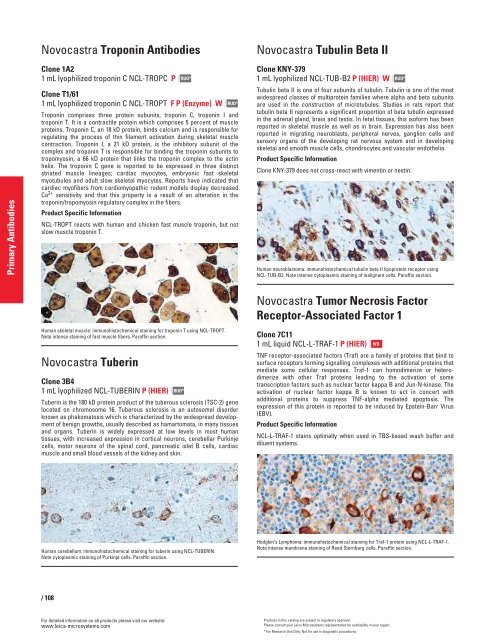QF0159 Marketing Release Record
QF0159 Marketing Release Record
QF0159 Marketing Release Record
You also want an ePaper? Increase the reach of your titles
YUMPU automatically turns print PDFs into web optimized ePapers that Google loves.
Primary Antibodies<br />
Novocastra Troponin Antibodies<br />
Clone 1A2<br />
1 mL lyophilized troponin C NCL-TROPC P<br />
Clone T1/61<br />
1 mL lyophilized troponin C NCL-TROPT F P (Enzyme) W<br />
Troponin comprises three protein subunits, troponin C, troponin I and<br />
troponin T. It is a contractile protein which comprises 5 percent of muscle<br />
proteins. Troponin C, an 18 kD protein, binds calcium and is responsible for<br />
regulating the process of thin filament activation during skeletal muscle<br />
contraction. Troponin I, a 21 kD protein, is the inhibitory subunit of the<br />
complex and troponin T is responsible for binding the troponin subunits to<br />
tropomyosin, a 66 kD protein that links the troponin complex to the actin<br />
helix. The troponin C gene is reported to be expressed in three distinct<br />
striated muscle lineages; cardiac myocytes, embryonic fast skeletal<br />
myotubules and adult slow skeletal myocytes. Reports have indicated that<br />
cardiac myofibers from cardiomyopathic rodent models display decreased<br />
Ca 2+ sensitivity and that this property is a result of an alteration in the<br />
troponin/tropomyosin regulatory complex in the fibers.<br />
Product Specific Information<br />
NCL-TROPT reacts with human and chicken fast muscle troponin, but not<br />
slow muscle troponin T.<br />
Human skeletal muscle: immunohistochemical staining for troponin T using NCL-TROPT.<br />
Note intense staining of fast muscle fibers. Paraffin section.<br />
Novocastra Tuberin<br />
Clone 3B4<br />
1 mL lyophilized NCL-TUBERIN P (HIER)<br />
Tuberin is the 180 kD protein product of the tuberous sclerosis (TSC-2) gene<br />
located on chromosome 16. Tuberous sclerosis is an autosomal disorder<br />
known as phakomatosis which is characterized by the widespread development<br />
of benign growths, usually described as hamartomata, in many tissues<br />
and organs. Tuberin is widely expressed at low levels in most human<br />
tissues, with increased expression in cortical neurons, cerebellar Purkinje<br />
cells, motor neurons of the spinal cord, pancreatic islet B cells, cardiac<br />
muscle and small blood vessels of the kidney and skin.<br />
Human cerebellum: immunohistochemical staining for tuberin using NCL-TUBERIN.<br />
Note cytoplasmic staining of Purkinje cells. Paraffin section.<br />
/ 108<br />
For detailed information on all products please visit our website:<br />
www.leica-microsystems.com<br />
RUO*<br />
RUO*<br />
RUO*<br />
Novocastra Tubulin Beta II<br />
Clone KNY-379<br />
1 mL lyophilized NCL-TUB-B2 P (HIER) W<br />
Tubulin beta II is one of four subunits of tubulin. Tubulin is one of the most<br />
widespread classes of multiprotein families where alpha and beta subunits<br />
are used in the construction of microtubules. Studies in rats report that<br />
tubulin beta II represents a significant proportion of beta tubulin expressed<br />
in the adrenal gland, brain and testis. In fetal tissues, this isoform has been<br />
reported in skeletal muscle as well as in brain. Expression has also been<br />
reported in migrating neuroblasts, peripheral nerves, ganglion cells and<br />
sensory organs of the developing rat nervous system and in developing<br />
skeletal and smooth muscle cells, chondrocytes and vascular endothelia.<br />
Product Specific Information<br />
Clone KNY-379 does not cross-react with vimentin or nestin.<br />
Human neuroblastoma: immunohistochemical tubulin beta II lipoprotein receptor using<br />
NCL-TUB-B2. Note intense cytoplasmic staining of malignant cells. Paraffin section.<br />
Novocastra Tumor Necrosis Factor<br />
Receptor-Associated Factor 1<br />
Clone 7C11<br />
1 mL liquid NCL-L-TRAF-1 P (HIER)<br />
TNF receptor-associated factors (Traf) are a family of proteins that bind to<br />
surface receptors forming signalling complexes with additional proteins that<br />
mediate some cellular responses. Traf-1 can homodimerize or heterodimerize<br />
with other Traf proteins leading to the activation of some<br />
transcription factors such as nuclear factor kappa B and Jun-N-kinase. The<br />
activation of nuclear factor kappa B is known to act in concert with<br />
additional proteins to suppress TNF-alpha mediated apoptosis. The<br />
expression of this protein is reported to be induced by Epstein-Barr Virus<br />
(EBV).<br />
Product Specific Information<br />
IVD<br />
NCL-L-TRAF-1 stains optimally when used in TBS-based wash buffer and<br />
diluent systems.<br />
Hodgkin’s Lymphoma: immunohistochemical staining for Traf-1 protein using NCL-L-TRAF-1.<br />
Note intense membrane staining of Reed Sternberg cells. Paraffin section.<br />
Products in this catalog are subject to regulatory approval.<br />
Please consult your Leica Microsystems representative for availability in your region.<br />
* For Research Use Only. Not for use in diagnostic procedures.<br />
RUO*
















